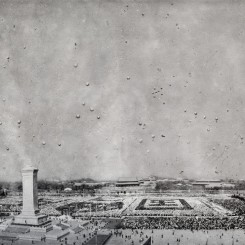Ground Control to Major Zhang
Nationalism and Memory
“1959 National Day” (2010), an epic tableau — 430 x 1,000 cm — presents the mass celebration from a raised perspective, looking down the square to the East Gate of the Forbidden City (the Tiananmen), upon the gathered ant-like multitudes. Balloons crowd the sky — more numerous than in the source image — and smoke seems to rise from numerous points, perhaps the trails of fireworks. With their ribbon-tails, the balloons seem spermatozoa-like, not communicating with the stars as Cai Guo-Qiang’s fireworks are meant to, but impregnating the sky. Does it represent the birth of a nation? The Great Leap Forward had failed. The country was economically shattered. Millions were starving or dead. Consider then the Orwellian-denoted “1984 National Day No.2,” (2010) in which a black maelstrom is engulfing Tian’anmen square.
Another series of portraits also from 2010, “Puyi”, “President Yuan,” and “Pu Chung-hsi” and “Soldier,” show military men, each with medals, but while the young unknown soldier has only one (for shooting), the “great men” are covered in them (for whatever). By contrast, “Voice from Shan Bei” (2009) depicts Zhou Enlai, on the phone to his militia in the campaign defending Shaanxi Province against Chiang’s Nationalists, calm, concentrated, even as shrapnel — pieces of charcoal — appear to emanate out of the telephone. (8) As a nod to London, a portrait of “Churchill,” (2012) is also here. Notably, except Zhou Enlai and presumably the anonymous soldier, all of these individuals changed ‘sides,’ whether by force of circumstance or opportunistically, even Churchill, and to which list may be added “Chiang Kai-Shek and Hu Hanmin,” (2010) and “Pai Chung-Hsi,”(2010).
Buddhism
According to Buddhism, the four fundamental elements are water, earth, fire and air, and in China sometimes also a fifth: metal. But here water, the element of cohesion, is absent. The ash works, phoenix reincarnations, literal carbon copies, are also desiccated ghosts desperate for water.
Zhang Huan is a devoted Buddhist and his faith imbues his practice and life (his Gao An Foundation has supported construction of school buildings in dozens of economically deprived areas of China, including Sichuan and Tibet). (9) “The Mountain is Still a Mountain” refers to a key metaphor in the teachings of Yuan Weixin, a Chan [Zen] Buddhist master during the Tang Dynasty (608-917 AD):
The mountain is a mountain and water is water
The mountain is not a mountain and water is not water
The mountain is still a mountain and water is still water
It refers to intellectual transcendence, the acknowledgment, understanding and acceptance of conceptual reality: what is truly true. (10)
In “Chiang Kai-shek and Hu Hanmin” (2010) the general appears with his erstwhile colleague, who switched his allegiances from Sun Yat-Sen to Chiang, only later to be imprisoned for criticizing Chiang for mishandling the war against Japan, before becoming a nationalist leader in Southern China. It is a revelation. It shows that Zhang’s “Rui Yuan” portrait is actually cropped from the image of the two together. These black and white images document scenes as factual truths, whether of status (a leader) or historic (a celebration or construction project), but as we have seen, truth can be ambiguous, temporal and contextual — it has many lives and to fully appreciate it we must pursue it. Factual reality depends on how we treat it. Memory may be contingent but re-membering is a discipline.
_________
8. Shaanxi is home to Yan’an, the Communist headquarters following the Long March.
9. See www.shgaoan.org
10. Chan Buddhism adapted traditional Buddhism to China, including adopting aspects of Daoism.



